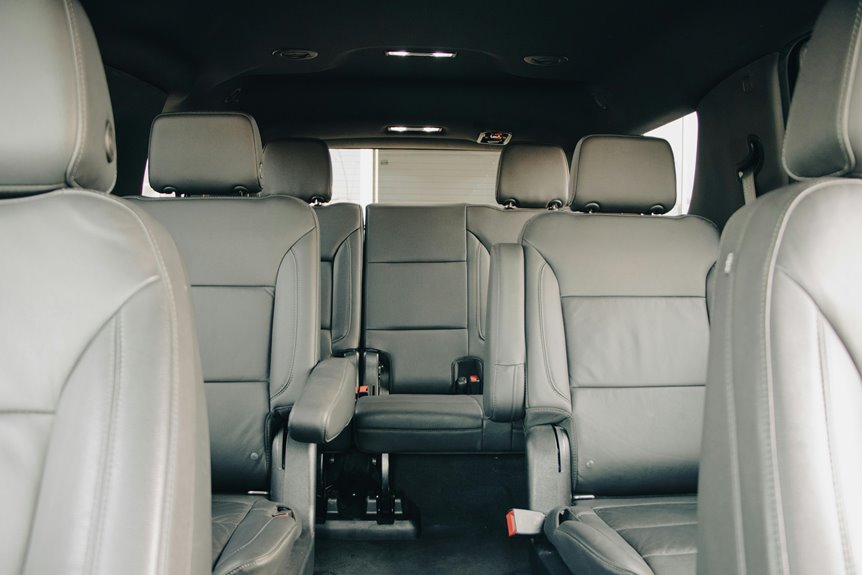You might recall the saying, “tough as leather,” but does that reputation hold up when your family’s daily chaos meets your furniture? You want upholstery that can endure spills, scratches, and constant use without losing its charm. Understanding how leather compares to fabric and what makes certain leather types more resilient can help you make a smart choice—yet there’s more to durability than just toughness.
Table of Contents
Key Takeaways
- Leather offers superior durability and resistance to scratches and spills, making it ideal for busy family homes.
- Full-grain leather provides maximum strength and develops a rich patina, enhancing longevity and character.
- Leather is easier to clean and maintain than fabric, resisting stains and wear from daily family use.
- It withstands high traffic, maintains shape, and ages gracefully, unlike many fabrics that wear out faster.
- Although more expensive initially, leather’s durability and low maintenance deliver better long-term value for families.
Comparing Leather and Fabric Durability
Although both leather and fabric have their strengths, leather generally offers greater durability for families.
Leather typically provides superior durability, making it an ideal choice for busy family homes.
When you compare fabric resistance, most fabrics tend to wear out faster due to spills, stains, and daily use. Even high-quality fabrics can lose their appearance over time, especially in busy households with kids or pets.
Leather, on the other hand, stands up well to scratches and spills, and it’s easier to clean. Plus, you might worry leather feels hot or sticky, but leather breathability actually helps regulate temperature, making it comfortable year-round.
While fabric can offer more color and pattern options, leather’s toughness and ability to age gracefully often make it the smarter choice when durability is your priority.
Characteristics of Full-Grain and Top-Grain Leather
When choosing leather upholstery, understanding the differences between full-grain and top-grain leather can help you make a better decision.
Both come from the hide’s top layer but differ in grain variations and leather finishes.
- Full-grain leather retains the natural grain, offering maximum durability and unique markings.
- It develops a rich patina over time, enhancing its character without heavy finishes.
- Top-grain leather is sanded to remove imperfections, creating a smoother, more uniform surface.
- It often has a protective finish, making it more resistant to stains but slightly less breathable.
Knowing these characteristics lets you pick leather that suits your family’s lifestyle, balancing durability and appearance effectively.
Maintenance Tips to Extend Leather Furniture Lifespan
Understanding the qualities of full-grain and top-grain leather helps you appreciate how proper care impacts their durability.
To extend your leather furniture’s lifespan, adopt effective cleaning techniques like wiping spills immediately with a soft, damp cloth. Avoid harsh chemicals that can damage the leather’s surface.
You should also apply protective coatings regularly to shield against stains and wear, especially in high-use areas. Conditioning the leather every six to twelve months prevents it from drying out and cracking.
Keep your furniture away from direct sunlight and heat sources to maintain its natural oils.
How Leather Performs in High-Traffic Family Environments
Because families often put their furniture through constant use, leather stands out as a strong contender for durability in high-traffic environments.
For families facing constant use, leather proves incredibly durable and ideal for high-traffic spaces.
When you have family pets and kids, leather’s resilience becomes a major advantage. Here’s how leather performs under daily wear:
- Easy to clean — Leather resists most spills, helping you avoid stubborn leather stains.
- Scratch resistance — Though not invincible, leather handles pet claws better than many fabrics.
- Sturdy structure — It maintains shape and support despite frequent use.
- Aging gracefully — Leather develops a unique patina, adding character instead of looking worn out.
If you want upholstery that can take the chaos of family life without losing its appeal, leather is a smart choice.
Hypoallergenic Benefits of Leather Upholstery
Why choose leather upholstery if allergies are a concern?
Leather naturally resists dust mites, pet dander, and other common allergens, making it an excellent choice for allergy prevention in your home.
Unlike fabric, leather doesn’t trap airborne particles, so it’s easier to keep clean and reduces irritants that can trigger reactions.
If someone in your family has skin sensitivity, leather’s smooth surface means fewer allergens come into contact with their skin, minimizing discomfort.
You can quickly wipe down leather furniture, preventing buildup that worsens allergy symptoms.
Choosing leather helps create a healthier environment, especially if allergies or sensitive skin affect your household.
This hypoallergenic benefit makes leather a smart, practical option for families prioritizing comfort and well-being.
Cost and Long-Term Value of Leather Furniture
Although leather furniture often costs more upfront than fabric options, it offers significant long-term value that many families find worthwhile.
Leather furniture’s higher upfront cost is balanced by its lasting value and appeal over time.
When you conduct a cost analysis, consider these factors to understand the investment longevity of leather furniture:
- Durability reduces the need for frequent replacements, saving money over time.
- Leather’s resistance to stains and wear lowers maintenance costs.
- Classic leather styles retain value and often look better with age.
- Easy cleaning means fewer expenses on professional upholstery care.
Environmental Impact of Choosing Leather Over Fabric
When you weigh the environmental impact of leather versus fabric upholstery, several factors come into play. Leather often involves animal welfare concerns and requires sustainable sourcing to minimize ecological harm. Fabric options vary widely, with some made from synthetic fibers that rely on fossil fuels, while others use natural, renewable materials.
| Aspect | Leather | Fabric |
|---|---|---|
| Resource Use | Animal-based, water-intensive | Can be plant-based or synthetic |
| Environmental Load | Tanning chemicals, emissions | Varies, some eco-friendly options |
| Sustainability | Dependent on sourcing practices | Depends on fiber type and treatment |
Choosing leather responsibly means ensuring sustainable sourcing, but fabric can offer lower-impact alternatives if you pick wisely.
Frequently Asked Questions
How Does Leather Respond to Extreme Temperature Changes?
When it comes to temperature resilience, leather can be a double-edged sword. You’ll find it reacts to climate impact by stiffening in cold and drying in heat, so it’s not always a walk in the park for extreme changes.
Can Leather Upholstery Be Repaired if Scratched or Torn?
You can repair leather upholstery if it’s scratched or torn by using scratch repair kits designed for leather maintenance. Regular care helps prevent damage, but even deeper issues can often be fixed by professionals to restore your leather’s look.
What Types of Leather Finishes Are Best for Homes With Pets?
Imagine your dog’s claws on a sofa—pet friendly finishes like top-grain leather help you resist scratches. You’ll appreciate how easier leather maintenance keeps your furniture looking great despite your furry friends’ daily adventures.
Does Leather Furniture Emit Any Odors When New?
When you get new furniture, you might notice a leather scent. It’s common for leather to emit that fresh, natural odor, but it usually fades quickly once the piece’s aired out in your home.
How Does Leather Age in Humid Versus Dry Climates?
You might think leather cracks in dry climates, but with leather maintenance tips like regular conditioning, you’ll prevent that. In humid areas, humidity effects can cause mold, so keep ventilation high and clean your leather often to protect it.
- What Fabric Is Best for Durable Hammocks? - June 6, 2025
- Most Durable Fabric for Boat Covers: Resisting Sun, Salt, and Mildew - June 6, 2025
- Polyester vs. Nylon for Outdoor Gear: Which Offers Better Durability? - June 6, 2025







